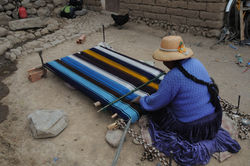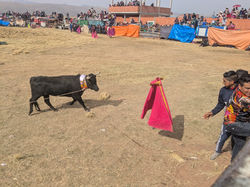
EXPERIENTIAL TOURISM
This form of tourism fosters respectful and profound cultural exchange. It is essential for the preservation and enhancement of the local culture because it generates direct income for communities, strengthens collective identity, and fosters a sense of belonging to one's roots. Furthermore, it encourages the intergenerational transmission of cultural practices that, without concrete recognition, would risk disappearing. Discover our proposals and contact us to learn more about the plateau:
Aymara culture has its roots in ancestrals time, where every gesture is memory and every ritual is life. Coca leaves, sacred for the culture, accompany the journey, work, and prayer: they are a bridge between body and spirit, between man and Pachamama.
Figures such as the "amauta," spiritual guide and guardian of ancestral knowledge, keep alive the connection with the forces of nature and cosmic cycles. In communities, the apthapi—the collective act of sharing food—is more than a meal: it is an act of union and reciprocity.
Aymara traditions are expressed in every ceremonial dance, every costume, every rhythm that resonates during celebrations: not folklore, but identity in motion. It is a culture that endures, teaches, and celebrates—even today, with strength and dignity.
AYMARA CULTURE
 |  |  |
|---|---|---|
 |  |  |
 |  |
COUNTRY LIFE
In the Bolivian Andean plateau, agriculture is more than just sustenance: it's a living heritage. For centuries, dozens of native potatoes have been grown here, adapted to frost and altitude. Some, like tunta, are processed using ancient dehydration methods that ensure their preservation for years. Along with tunta, ch'uño is also produced, also obtained from the natural dehydration of potatoes through nighttime frost and daytime sun, a process passed down through generations. Alongside these, among other strains, quinoa is grown, the rich and resilient "golden grain" of the Andes, and fava beans, nutritious and versatile, the basis of many traditional dishes.
The agricultural mosaic is completed by crops such as tarwi (Andean lupin), cañahua, morocho corn, and oca, all adapted to an extreme climate and grown using sustainable techniques. The work is mostly done by hand, with meticulous care, and only occasionally are small tractors or simple wooden plows pulled by oxen used.
Every sowing, every harvest, reflects a profound balance between man, land, and time: agriculture here is still an act of respect, resistance, and identity.
 |  |  |
|---|---|---|
 |  |  |
 |  |  |
 |  |  |
 |
HAND WEAVING
Hand weaving is a living art that intertwines threads and history. Men and women, seated on the ground, work on looms nailed to the ground, using simple tools—often polished animal bones—and expert hands that follow techniques passed down through the centuries. Each fabric is unique: the colors, the symbolic geometries, the motifs that tell the story of the community, the landscape, and the times. In every thread, the patience and knowledge of a people who continue to tell their story through the silent intertwining of wool and tradition.
 |  |  |
|---|---|---|
 |  |  |
 |
PRODUCTION OF TRADITIONAL "CRIOLLO" CHEESE
The production of Criollo cheese is a daily ritual that begins at dawn. Women and men hand-milk cows, often raised in small family herds, free-roaming on high-altitude pastures, for a few liters of milk.
The fresh milk is slowly heated, curdled without chemical additives, and pressed using simple yet precise techniques. The result is a fresh, white, and firm cheese, then hand-salted and left to rest for a short time. Each piece retains the flavor of the pasture, the Andean sun, and patient labor.
It is a humble cheese, but deeply rooted in identity: it nourishes families and local markets.
 |  |  |
|---|---|---|
 |
FESTIVAL OF THE "VIRGEN DE LA NATIVIDAD"
Every year, the small Andean town of Peñas is transformed into an explosion of faith, music, and color during the festival of the Virgen de la Natividad. It is a sacred and festive moment, where profound worship intertwines with the collective energy of traditional dances, performed in costumes rich in symbols and movements charged with meaning.
In particular, the "mucululos," a ceremonial dance tied to the agricultural cycle, is performed as a ritual prayer to the Aymara deities to ensure a good harvest season. With masked figures, somewhere between burlesque and ritual, they open and accompany the procession of the Virgen de la Natividad. Bullfighting, followed with passion, and the popular fair complete the picture: a space for encounters between the sacred and the profane, between past and present.
 |  |  |
|---|---|---|
 |  |  |
 |  |  |
 |  |  |
 |  |  |
 |
CONTACT US
FOR INFO
Peñas, Provincia Los Andes, La Paz (Bolivia)
(+591) 63057462

(+591) 74018297
Agency
Visit our pages:


